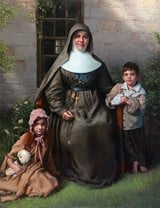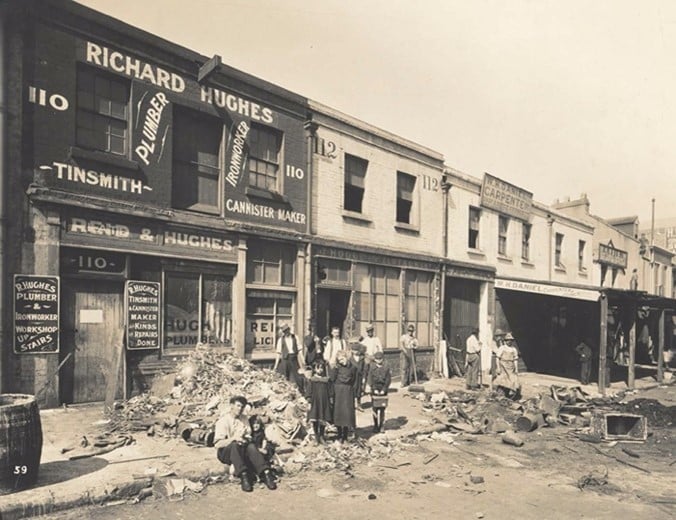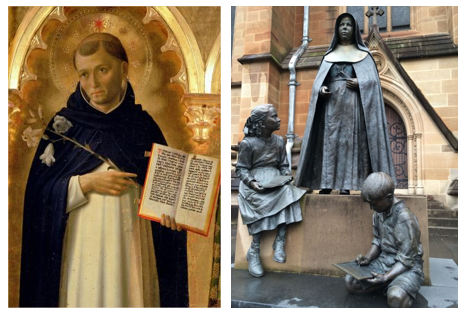HOMILY FOR MASS OF SUNDAY THE FEAST OF ST. MARY MACKILLOP

Live-streamed from St. Mary’s Basilica, Sydney, 8 August 2021
When Mary MacKillop was about 20 years old, living in Portland, Victoria, she was accidentally locked in the church overnight. Sounds rather spooky, but Mary counted it an opportunity to spend all-night in vigil with Our Lord.[1] It was a turning point in her life. Her great mission of serving God’s young and poor, especially through education, began as all true missions do in contemplation. We can be distracted by Mary’s extraordinary activity and achievements and forget that she was, before all else, a woman of prayer. In fact, her sisters Annie and Lexie teased Mary that she made her home, wherever she was, into a ‘convent’ with her endless prayers.[2] Perhaps they thought she was just malingering or, worse, playing the saint: little did they know! But it was in prayer that Mary heard God’s call to educate young Australians and to do so through her own version of religious life.
Our saint’s story began 22 years before, when Alex MacKillop, an ex-seminarian, emigrated to Australia and here married another Scots émigré, Flora MacDonald. He was a strong influence on their seven children, especially the eldest, Mary-Helen. But Alex never really settled down: he was at sea or on the road most of his life. And he was clueless with money, so his family was poor. Mary reacted against her father’s poor administration, but she inherited his gadabout tendencies and one of the quotes on her tomb is “Remember we are but travellers here”.
Absent her father, Mary went to work at age 16 to support the family as a shop assistant and then governess. Then came her fateful meeting with Fr Julian Tenison-Woods: together they opened a free Catholic school in Penola and founded the ‘Sisters of Saint Joseph of the Sacred Heart’ in 1866. By 1869, when Mary took her final vows, there were already more than 70 sisters, educating children at 21 schools, as well as working with orphans, street kids, the elderly and dying. So began an extraordinary religious order (or two) and an even more extraordinary network of schools, convents and charitable institutions, providing care of various kinds, but above all exposing all-comers, especially the poor, to the love of God and especially Mary’s system of education based on the four Rs of reading, writing, ’rithmetic and religion.[3]
It wasn’t an easy road for Mary, who had taken “of the Cross” as her religious surname. She struggled with bishops, the more supportive ones being absent when she needed them, the less supportive ones being all too present and energetic; with friction with Tenison-Woods, other clergy, even some sisters; with sometimes hostile press and always financial challenges; with the geography of a continent (and world) which was her mission-field; with the sudden death of her mother in a ship-wreck; and with suffering a stroke herself. But her upbringing in adverse circumstances made her hardy, like her iconographical emblem, the eucalyptus. We can picture her in heavy habit on horseback in the heat and dust taking on the bush and desert, determined to bring the love of God to those Pope Francis calls ‘at the peripheries’. Through all this she never wavered in her trust in God, as she taught her daughters and as her tomb again attests.
Mary embraced wholeheartedly Christ’s advice in our Gospel not to worry about what you are to eat or wear, not because these things don’t matter but because “life is so much more than food, and the body so much more than clothing!” Just think of the wild flowers dressed in glorious robes and know your heavenly Father cares much more for you (Mt 6:25-34). Mary’s exceptional trust in divine providence allowed her to pursue her higher purpose undeflected.
We, too, can take comfort from Christ’s assurance today that He knows our needs and will look after us; if we first set our hearts on His kingdom, all else will fall into place. We are challenged by the current pandemic, as MacKillop was by many things, to re-examine our priorities and recalibrate our compass so that it points us to God’s kingdom. It’s not always straightforward but if we remain on track we will not be alone.
So if we’re not to worry about what we eat or wear, does that mean we walk around naked and hungry? Clearly not! Mary chose and provided a common habit for her sisters. She knew that “God helps those who help themselves” or that we should “Pray as if everything depends upon God and act as if everything depends upon you.”[4] To be individuals who respond reliably to divine providence and the kind of community that cultivates such character, St Paul offers us an excellent blueprint: clothe yourselves in the religious habit of “compassion and kindness, humility, gentleness and patience… forbearing and forgiving each other” (Col 3:12-17).

In the present lockdown our homes can become hothouses with so many having to study or work in one confined space 24/7, for weeks on end. We need to heed his call to “bear with one another; forgive each other as soon as a quarrel begins… put on love… and always be thankful.”
None of which, you might say, is any monopoly of Christians – it’s just common sense, common decency. But as if presciently addressing us on how to live a healthy lockdown as Christians, Paul continues: “let Christ’s peace reign in your hearts” and homes. As if aware of the challenges of learning from home, Paul says “teach and advise each other… in all wisdom”. And, as if aware of our present need to worship from within the domestic church he also says “let the message of Christ reign in your homes” and “with gratitude in your hearts, sing psalms and hymns and sacred music to God”. As Mary MacKillop observed more than once, the readings of the day at Mass often speak very directly to our present circumstances!
In this time of pandemic we might recall another part of the story of Mother Mary of the Cross and her daughters. In 1881 Sr Josephine Carolan RSJ, who had been involved in public contest with Bishop James Quinn of Brisbane over attacks on Mary MacKillop, was removed with the other sisters to the relative safety of Sydney.
Having connections in the Bank of Queensland, she was able to secure the credit to purchase ‘Cheshunt’, a large three-storeyed building in the Rocks, next door to the old St Michael’s Church, as a third Josephite House of Providence. It accommodated 12 sisters and 36 destitute residents, including 22 street-kids or orphans. The very name ‘House of Providence’ spoke loudly of MacKillop’s spirituality. Mary lived there in the 1880s until she moved to North Sydney. It was for a time a noviciate house and while Sister Bonaventure, the then-leader of the NSW province, lived there it was also the Provincial House.[5]
We are not the first generation to suffer a pandemic. The worst one in history was the so-called Black Death or Bubonic Plague which came in waves from at least the fourteenth century to the nineteenth. The last of those waves emerged in Northern China in 1855, and though pandemics spread more slowly in those days, it had reached Hong Kong by 1894, India by 1896, and Noumea by 1899. The following year it hit the Rocks in Sydney and health authorities imposed a severe lockdown.

The newly-formed Plague Department set about disinfecting houses with lime and carbolic water, knocking down and burning things, and paying tuppence per rat delivered to the Bathurst Street incinerator.[6] The sisters and their clients were forced to leave the Rocks, but the government offered some compensation, which allowed for funding a girls’ orphanage at Lane Cove. So the Josephites can testify that good can come even from pandemics!
Despite the parallel challenges of today, we recognise the heroes who went before us and often suffered much worse than we. We are blessed to be able to connect electronically when we are physically distanced; Mary had to engage in endless, exhausting journeys to keep in touch with her sisters and beloved children. If she could do it, we too can surely find ways to reach out to the financially, educationally or spiritually poor of our time. Together with Mary MacKillop let us don the religious habit of Christ’s love and offer His strength and comfort to all thirsty souls (Ps 62/63:1-8).
WORDS AFTER COMMUNION ON THE FEAST OF ST. MARY MACKILLOP
Live-streamed from St. Mary’s Basilica, Sydney, 8 August 2021
Thank you Sr Monica for your beautiful words. Four recognised saints have visited this basilica: St Paul VI, St Teresa of Calcutta and St John Paul II – but St Mary MacKillop was the first. My thanks to you all for taking part in today’s celebration of the Feast of St Mary of the Cross MacKillop. As the principal patron of Australia, alongside Our Lady Help of Christians, we implore her intercession for our country during this time of pandemic and other challenges.
One of those challenges is the unremitting crusade of some secularists to marginalise faith and believers. Mary MacKillop responded with her enormous network of schools, ensuring that families had the option of an education for that children that included God. The latest campaign of the secularists is to press anyone who doesn’t regularly attend church to mark themselves as ‘no religion’ on the census. This is seriously misleading: we know that many people with faith practise only irregularly, or who connect to God and Church in ways other than Mass attendance. But not only is this campaign deceptive, it also reduces our ability to get reliable information on where our people are, and so where we must concentrate infrastructure and services such as Catholic churches, schools, hospitals, aged care, welfare and pastoral care. And by giving a distorted picture of who and where we are, the secularists hope to use the census as yet another excuse for denying believers a voice in the public square. Please ask all your family and friends to mark their true religion on the census.
On behalf of us all here at St Mary’s Cathedral, a very happy feast day!
[1] Paul Gardiner SJ, An Extraordinary Australian: Mary MacKillop (2011) p. 47
[2] Gardiner, p. 57
[3] https://www.sosj.org.au/wp-content/uploads/2019/07/The-Original-Rule-1868.pdf: “The sisters… are to be moderately grave, yet cheerful, making their children happy by the way in which they show in practice that the service of the Lord is sweet. Let them remember that children will he attracted to Jesus by a bright smiling exterior, but would be repelled by too much gloom, or spoiled by boisterous hilarity. The Sisters must not allow themselves to be irritated by the noise or perverseness of the children, but should speak gently, remembering what a holy office it is to form all those tender souls to virtue. They should talk cheerfully to their charges, so as to gain their young hearts, and, bearing in mind that the besetting sins of children in school are the germs of sloth, jealousy, vanity, and want of charity one towards another, they should try by word and example to eradicate these defects from them… Even in their most tender age they should begin to prepare their young minds for the reception of the Blessed Sacrament, speaking of it so as to get them to form a high idea of it beforehand. In short; they should do their utmost to make the little ones of the Church the means of drawing God’s blessing upon all, and the seeds of the future perfection of their generation. In teaching they should take every pains, leaving nothing untried as a matter of justice to the parents, that the children may progress in worldly learning.”
[4] This last saying has been attributed to St Augustine, Martin Luther, St Ignatius Loyola, President John F. Kennedy, Rabbi Ferdinand Isserman. The Catechism attributes the saying to St Ignatius (CCC 2834, citing Joseph de Guibert SJ, The Jesuits: Their Spiritual Doctrine and Practice (Chicago: Loyola University Press, 1964), p. 148, n. 55; the Latin text of the Catechism cites instead Peter of Ribadeneyra, Tractatus de modo gubernandi sancti Ignatii, c. 6, 14).
[5] https://www.sosj.org.au/first-three-houses-providence/
[6] https://www.nma.gov.au/defining-moments/resources/bubonic-plague
Welcome to St Mary’s Cathedral in Sydney, for the Mass the Solemnity of St Mary of the Cross MacKillop. It’s not often the feast day of a saint supersedes the Sunday celebration of Christ’s resurrection, but saints are of course reflections of the triumph of Christ’s grace and Australia’s first saint is no exception. In these hard times of pandemic we recall that Mary was herself no stranger to adversity, and we ask for some of her courage and clear-sightedness in such circumstances.

This week we celebrated the 800th anniversary of the death of St Dominic: all around the world his feast is celebrated today, on 8th August. All around the world, that is, except in Australia, where he’s trumped by Mary MacKillop. But being the gentleman he was, I am sure Dominic was happy to defer to the first ever recognised Australian saint. It is my special privilege to welcome today as our readers, Mary MacKillop’s successor as congregational leader, Sr Monica Cavanagh RSJ with Sr Josephine Dubile RSJ. To all the sisters at the MacKillop Shrine in North Sydney and elsewhere, a very happy feast day! To everyone watching via livestream: remember that Australia needs more saints, it needs you to be a saint, and so let us repent of the times we failed to be so…

